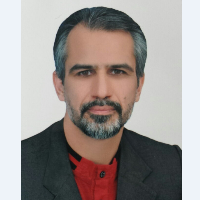Evaluation of Using Time Effect of Total (Metsulfuron Metyl25%+Sulfusulfuron75%) Herbicide on Some Traits of Spontaneous barley (Hordeum spontaneum K. Koch) Ecotypes
Author(s):
Article Type:
Research/Original Article (دارای رتبه معتبر)
Abstract:
Introduction
Spontaneous barley is a category of cereal, annual plant, winter, self-pollinated, and diploid (2n=14). It has very close genetic relationship with barley. Very long awn, resistant to drought and salinity, seed dormancy and allelopathic potential are the features of this plant. The average 1000-seed weight without awn is 45grams and with awn is 47grams.Apart of the five provinces (Semnan, Golestan, Mazandaran, Guilan, Sistan and Baluchestan), the existence of this species was reported in Iran. The highest prevalence belongs to Fars province with an average density of 34 plants per square meter.Due to genetic and morphological similarities of spontaneous barley with wheat and barley, none of selective herbicide for wheat are able to control spontaneous barley.This study aimed to investigate the effects of the herbicide metsulfuron methyl + Sulfosulfuron (TOTAL) on morphological and reproductive characteristics of different ecotypes spontaneous barley and determine the best of use time these herbicides in the various growth stages of spontaneous barley.
Materials and Methods
This experiment performed in Varamin region during 2013 and 2014 in form of Factorial randomized complete block design with four replications. The first factor included two levels of MetsulfuronMetyl+ Sulfosulfuron herbicide application at two leaf (GS =12) and second node (GS = 32) stages of growth spontaneous barley, and control without herbicide. The second factor was 20 ecotypes, which collected from across the country. At thirty days after the treatment which was equivalent to the heading stage of spontaneous barley, a box (0.5 × 0.5) was dropped on each line and then the morphology and reproductive traits of spontaneous barley were recorded.
Results and Discussion
The greatest effect of TOTAL herbicide was at the time of the second node, but in two leaf also had a significant effect on reducing the density of spontaneous barley. Ecotypes Shush, Marvdasht, Urima, Shahreza, Islamabad, Isfahan, Golpayegan and Varamin after herbicide application at two stages were significantly more than control in term of plant density reduction. The use of herbicide reduced the number of stems per plant. Differences between treatments indicate that the effect of herbicides on stem growth has been positive. Totally, stems per plant reduction caused to reduction of the fruiting stems. This causes to reduce reproductive efficiency in spontaneous barley. In Ecotypes of Shush, Darab, Mahabad, and Biseton areas, effective of herbicides on leaf area index was higher at the two-leaf stage. Reduction of leaf area reduced the size and plant dry weight. TOTAL herbicide caused to weaken plants and plant density reduction by reducing the leaf area growth, and the growth of young stems. In Mahidasht, Fasa and Zarghan ecotypes, herbicide application at two leaves stage reduced the plant height more than second node stage. Using herbicides at second node stage,significantly changed the height of Salmas, Miandoab, Darab, Biseton, Shahryar, Golpayegan and shahreza ecotypes compared to control. Final height is one of the most important and effective indicator, in terms of weed-crop competition, which by light advantage, resulted to increasing the canopy, leaf area, dry weight and better competitive conditions. The use of herbicides at the two-leaf and the second node stages resulted incontrolling the final height of spontaneous barley compared to control. The plant fresh weight and dry weight of ecotypes showed a significant decrease as compared to the control. By reduction of spontaneous barley fresh weight, the reproductive ability reduced and also the canopy was decreased, which both have an important role on control of spontaneous barley. Moreover, according to another study among several tested herbicides in wheat, spontaneous barley did not lead to optimal control and only TOTAL decreased the dry weight by 67 percent. Using herbicides at second node stage resulted to reduction of spike weight in Shush, Fasa, Shiraz, Kerend and Varamin ecotypes than control. After herbicide application, due to unfavorable growing conditions and stress, the plant with minimal resources went to reproductive stage. Consequentlythe plants were weaker as compared to the control.Finally,the fertility rate reduced and spike length was shorter under the influence of herbicides. Using of herbicides at second node, most of the ecotypes showed seed weight reduction.
Conclusion
The results showed that the use of TOTAL herbicide at the two-leaf stage and the second node decreased morphological and reproductive characteristics of this weed. The biggest influence on morphological characteristics of the Bistoon ecotype (density), Shiraz ecotype (plant density, leaf area, fresh weight, Dry weight, spike length), Rāmhormoz ecotype (number of stems, plant fresh weight, Dry weight), Mahidasht ecotype (LAI), Fasa ecotype (height, leaf area index, fresh weight, dry weight, grain weight, spike weight), Golpayegan ecotype (final height), Branch ecotype (final height), Shush ecotype (number of stems, number of grains per spike), Marvdasht ecotypes (seed weight, weight spike), Zarghan ecotype (spike length). Ecotypes reactions to the herbicide suggested that potential genetic differences among ecotypes creates different conditions of increasing or decreasing of the studied traits. Knowing these differences guide us to control this weed at different stages of plant growth by suitable approaches.Keywords:
Language:
Persian
Published:
Journal of plant protection, Volume:32 Issue: 3, 2018
Pages:
373 to 384
magiran.com/p1933784
دانلود و مطالعه متن این مقاله با یکی از روشهای زیر امکان پذیر است:
اشتراک شخصی
با عضویت و پرداخت آنلاین حق اشتراک یکساله به مبلغ 1,390,000ريال میتوانید 70 عنوان مطلب دانلود کنید!
اشتراک سازمانی
به کتابخانه دانشگاه یا محل کار خود پیشنهاد کنید تا اشتراک سازمانی این پایگاه را برای دسترسی نامحدود همه کاربران به متن مطالب تهیه نمایند!
توجه!
- حق عضویت دریافتی صرف حمایت از نشریات عضو و نگهداری، تکمیل و توسعه مگیران میشود.
- پرداخت حق اشتراک و دانلود مقالات اجازه بازنشر آن در سایر رسانههای چاپی و دیجیتال را به کاربر نمیدهد.
In order to view content subscription is required
Personal subscription
Subscribe magiran.com for 70 € euros via PayPal and download 70 articles during a year.
Organization subscription
Please contact us to subscribe your university or library for unlimited access!




